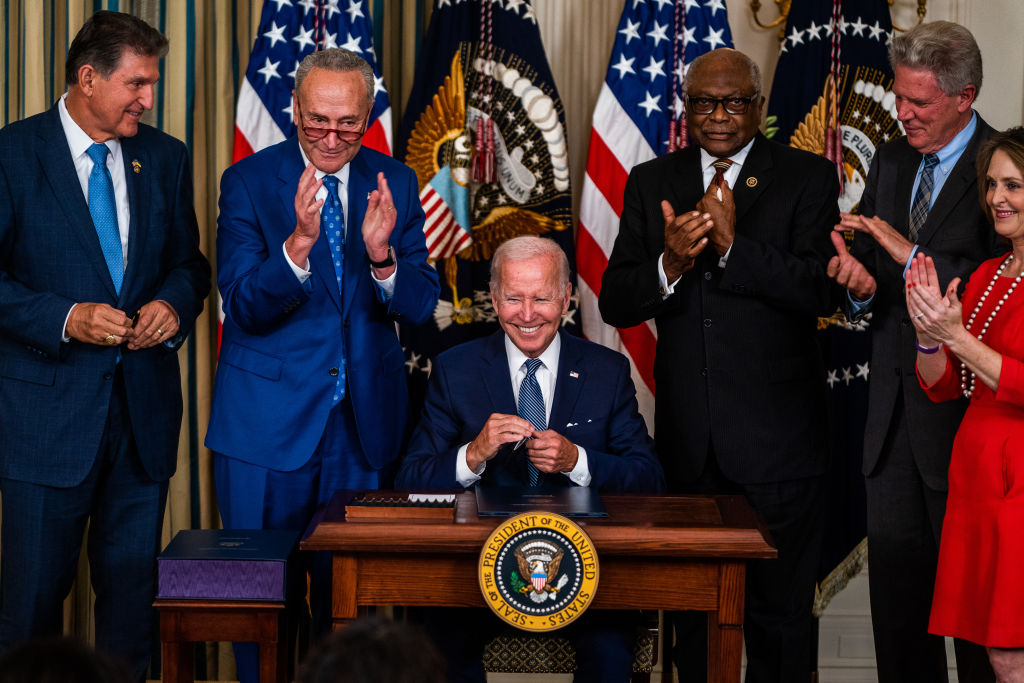
This summer, a political miracle occurred. Against powerful opposition and long odds, despite being written off by pundits, and by the narrowest of margins, we passed the biggest American climate action ever. The Inflation Reduction Act is predicted to push us from 25 percent to 40 percent reduction in greenhouse gas emissions by the end of the decade, and put the United States within striking distance of our emissions reduction targets.
While this is the most we’ve ever done, it’s still not enough to meet this planetary emergency. Climate change is a generational fight; no single law will solve this crisis, and every increment of reduced emissions is danger and pain avoided. There’s a tendency among policy experts to advocate for their favorite solution, to the exclusion of others. But given the scope of both the challenge and the opportunity, and given the size and momentum of our growing coalition, we have to embrace multiple lines of climate effort at the same time— executive and legislative, local and federal, private and public, and both emerging and proven technologies.
Here’s a roadmap for the next phase of the fight.
First, the Biden Administration must aggressively use the authorities it has. The EPA should implement stronger tailpipe emissions standards for trucks and cars, place stronger limits on methane emissions from oil and gas facilities, and issue regulations to cut both carbon and co-pollutant emissions from coal- and gas-fired power plants and major industrial emitters. These actions will protect people’s health and the environment, and they fall squarely within the agency’s core responsibilities. But the best way to ensure that the entire federal enterprise is working on climate action is to implement a robust social cost of carbon—a science-based estimate of the damages caused by each ton of carbon pollution—and require its use throughout government decision-making. If federal agencies are required to account for the real costs of carbon pollution, they will make more informed choices in their rule-making, procurement, investments, and other key areas of policy.
Agencies can complement the Inflation Reduction Act’s new incentives by sending a strong demand signal through federal purchasing. The buying power of agencies like the Department of Defense and the Department of Transportation will help create a market that pulls innovative, clean products into widespread use. This includes not just the electrification of vehicles, homes, and buildings, but also procurement of low-carbon industrial materials such as cement, concrete, and steel.
Read More: The Selfish Case for Climate Justice
The Department of Justice also has a role to play. Just like DOJ took tobacco companies to court and stopped them from lying to the public about the dangers of smoking, it must hold oil companies, trade associations, and front groups accountable for their disinformation campaigns to hide the dangers of fossil fuel combustion.
Second, the Biden Administration should reassert climate leadership on the global stage. We have finally established a real baseline of U.S. credibility on climate action. Now we need to leverage that progress in our diplomacy.
To make American companies more competitive in the global marketplace, we should institute a carbon border adjustment that places a fee on imports from countries that do little to cut carbon pollution in their industries. On average, the U.S. economy is much less carbon intensive than that of its trading partners, so a border adjustment fee would boost clean American manufacturing while putting intense economic pressure on foreign polluters. The European Union is already moving to impose a carbon border adjustment on its imports; now that the U.S. is taking significant steps to boost clean manufacturing, we should too, and encourage our allies to do the same.
Third, we need to implement the new law effectively. New programs will need to get funding out the door on a tight timeline. Much of the Inflation Reduction Act’s clean energy funding carries conditions that promote strong labor standards and domestically produced materials. That means implementation will require firm management, careful congressional oversight, and coordination with state, local, and Tribal governments, since a lot of crucial spending runs through states and communities.
We need to build big things—including big, planet-saving projects—at unprecedented speed and scale. The implementation of the Infrastructure Investment and Jobs Act and the new climate law is part of that, but we also need to make it easier to move fast and build out the clean energy infrastructure we urgently need. We can sensibly improve how we permit clean energy infrastructure without undermining core environmental laws. We need to rebuild our communities stronger and more resilient than ever before to withstand climate-fueled disasters such as wildfires, drought, and extreme weather.
Everything can feel impossible until it’s done. Though we face institutional challenges and a sinister opposition using dark money, deliberate misinformation, and a politicized Supreme Court, our biggest obstacle is despair. Now, we can grasp our biggest weapon: hope. But hope is a muscle—it must be exercised daily. Hope is not being blind to the magnitude of this problem. Hope is a determination that previous generations solved big problems, and we will too.
More Must-Reads from TIME
- Why Biden Dropped Out
- Ukraine’s Plan to Survive Trump
- The Rise of a New Kind of Parenting Guru
- The Chaos and Commotion of the RNC in Photos
- Why We All Have a Stake in Twisters’ Success
- 8 Eating Habits That Actually Improve Your Sleep
- Welcome to the Noah Lyles Olympics
- Get Our Paris Olympics Newsletter in Your Inbox
Contact us at letters@time.com